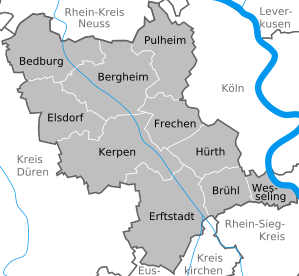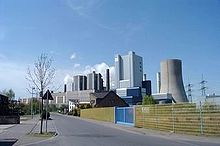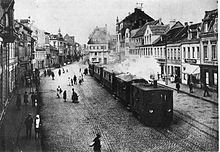Rhein-Erft district
| coat of arms | Germany map |
|---|---|
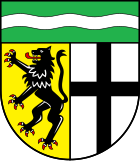
|

Coordinates: 50 ° 57 ' N , 6 ° 38' E |
| Basic data | |
| State : | North Rhine-Westphalia |
| Administrative region : | Cologne |
| Regional association : | Rhineland |
| Administrative headquarters : | Bergheim |
| Area : | 704.71 km 2 |
| Residents: | 470,615 (Dec. 31, 2019) |
| Population density : | 668 inhabitants per km 2 |
| License plate : | BM |
| Circle key : | 05 3 62 |
| NUTS : | DEA27 |
| Circle structure: | 10 municipalities |
| Address of the district administration: |
Willy-Brandt-Platz 1 50126 Bergheim |
| Website : | |
| District Administrator : | Michael Kreuzberg ( CDU ) |
| Location of the Rhein-Erft district in North Rhine-Westphalia | |
The Rhein-Erft-Kreis is a district in the west of North Rhine-Westphalia in the administrative district of Cologne . From 1975 until the end of October 2003 the district was called Erftkreis . The district town of the Rhein-Erft district is Bergheim , its largest city is Kerpen .
geography
Natural space
The district has a north-south extension of 38 kilometers and an east-west extension of 28 kilometers. The highest point of the circle is at 205.8 m above sea level. NN on the Glessener Höhe east of Bergheim . The northern Stommelerbusch , on the Pulheim city limits towards Dormagen and Cologne, has an altitude of only 42 m . This is where the lowest point of the district is located.
Forest cover
The Rhein-Erft district is one of the least forested districts in North Rhine-Westphalia with only around eleven percent forest and a per capita proportion of around 177 m². The national average of the wooded area of North Rhine-Westphalia is around 26 percent. With the decision to expand the Hambach open- cast lignite mine , around 1,300 hectares of forest fell away, and the proportion of forest has thus been further reduced to around eight percent. Against this background, a forest reproduction program was initiated in the Erftkreis. Within nine planting seasons (1993/1994 - 2001/2002) around 150 hectares have been reforested so far. This corresponds to a new planting of around 750,000 native deciduous trees and shrubs. The cities of Bedburg, Bergheim, Brühl, Erftstadt, Kerpen, Hürth, Pulheim and Wesseling actively support the forest reproduction program of the Rhein-Erft district and, in addition to their own local forest campaigns, have so far made an area of around 40 hectares available for supraregional reforestation.
Neighboring districts and neighboring cities
Bordering the Rhein-Erft-Kreis, starting clockwise in the north, is the Rhein-Kreis Neuss , the independent city of Cologne , the Rhein-Sieg-Kreis and the Euskirchen and Düren districts .
District cities
(Residents on December 31, 2019)
|

history

The Rhein-Erft-Kreis was established as part of the district reform in accordance with Section 26 of the Cologne Act on January 1, 1975 under the name Erftkreis from the former Bergheim (Erft) and Cologne districts (except for the parts that were added to Cologne) and the city of Erftstadt of the Euskirchen district newly formed. There were initially two administrative offices, namely Hürth and Bergheim . Since September 3, 1993, these have been combined into a single headquarters in Bergheim. On June 1, 1976, the city of Wesseling was added to the district area, which had to be spun off from the city of Cologne. This change gave the district access to the Rhine , but continued to be named only after the much less important Erft .
After the district council had decided to rename the district to Rhein-Erft-Kreis , the Interior Ministry of North Rhine-Westphalia approved the new name with effect from November 1, 2003. On September 25, 2003, the district administrator received the deed for renaming. The circle expects better international marketing from the new name.
Population statistics
| year | Residents |
|---|---|
| 1976 | 383.246 |
| 1980 | 399,322 |
| 1985 | 403.357 |
| 1990 | 419.414 |
| 1995 | 442.356 |
| 2000 | 455.487 |
| 2005 | 462,862 |
| 2010 | 464.130 |
| 2015 | 466.657 |
| 2018 | 470.089 |
Denomination statistics
According to the 2011 census , 229,753 of the population (50.9%) were Roman Catholic , 76,985 (17.1%) of the population were Protestant, and 32.1% were non-denominational or belonged to another religious community. Currently (as of December 31, 2018) of the 470,089 inhabitants, 218,700 (46.5%)% are Roman Catholic
politics
District council
The election for the district council in 2004 resulted in the following result (66 seats):
As of October 21, 2009, the 80 seats in the district council will be distributed as follows:
- CDU 33 seats
- SPD 23 seats
- Green 9 seats
- FDP 8 seats
- Left 2 seats
- Free voters Rhein-Erft 2 seats
- 2 seats per NRW
- non-attached 1 seat
Currently there is the following distribution of seats according to parliamentary groups in the district council (as of September 2014):
| CDU | SPD | Green | FDP | left | FW / pirates | non-attached | total |
|---|---|---|---|---|---|---|---|
| 31 | 24 | 9 | 4th | 3 | 3 | 2 | 76 |
| FW 2 PIRATES 1 |
Pro NRW 2 |
District administrators
- 1975–1983 Bernhard Worms , honorary district administrator
- 1983–1984 Willi Kaiser, honorary district administrator
- 1985–1995 Klaus Lennartz , honorary district administrator
- 1995–1999 Wolfgang Bell , first full-time district administrator
- 1999–2013 Werner Stump , first directly elected full-time district administrator
- 2013 Michael Kreuzberg
Upper District Directors
Until 1995 the district administrators were honorary. The administration was in charge of the senior district director during this time . With the assumption of administrative tasks by a full-time district administrator, the office of senior district director ceased to exist in North Rhine-Westphalia.
- 1975–1987 Helmuth Bentz
- 1987–1995 Wolfgang Bell , then first full-time district administrator
economy
In the future atlas 2016 , the Rhein-Erft district was ranked 193 out of 402 districts, municipal associations and independent cities in Germany and is therefore one of the places with a “balanced risk-opportunity mix” for the future. In the 2019 edition, it was number 131 out of 401.
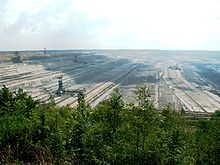
The Rhein-Erft district is characterized by natural resources, in particular lignite . The district lies in the center of the Rhenish lignite mining area . The RWE company operates one of the largest lignite power plants in Europe in the district (Bergheim- Niederaußem ) . The landscape of the region is also shaped by the large opencast mines . Entire villages had to give way to excavators. But also because of the good traffic situation, many companies settled in the district. You use the optimal surrounding structure as well as the proximity to the airport and the container train station Köln-Eifeltor .
In addition to the energy industry, the chemical industry is well represented in the south of the district , in particular petrochemistry and polymer chemistry . Major companies are found in Huerth in the chemical park and in Wesseling , including the refinery of Shell and the olefin production of LyondellBasell and polymer work of Braskem .
Healthcare
In all cities, except in Kerpen, Pulheim and Elsdorf, there are hospitals with basic and extended care. Most of the specialist clinics are in Hürth , the St. Katharinenhospital in Frechen is the academic teaching hospital of the University of Cologne and is home to the only neurological specialist clinic in the district, for example. A working group of self-help groups in the Rhein-Erft district is the point of contact for seekers.
traffic
Rail transport
Since the circle closes almost completely around Cologne on the left bank of the Rhine, the cities of the Rhein-Erft district are connected to the railway lines starting from Cologne:
- Hürth and Brühl on the Cologne – Bonn – Koblenz lines ( left Rhine line ) and Cologne – Euskirchen – Trier ( Eifel line )
- Frechen and Kerpen on the Cologne – Horrem – Düren – Aachen line (also S-Bahn )
- Pulheim on the Cologne – Grevenbroich – Mönchengladbach line
- Erftstadt on the Cologne – Euskirchen – Trier line (Eifel line)
- Bergheim on the route (Cologne-) Horrem-Bergheim-Bedburg (-Neuss)
- Bedburg to the Erftbahn and to the Düren – Neuss railway line
Bergheim and Bedburg are on the Erftbahn , a connecting route from Horrem to Bedburg. This is a stretch of the former Bergheimer Kreisbahn .
The Düren – Neuss railway line has only been operational as far as Bedburg since 1995. The Elsdorf-Düren section was excavated with the expansion of the Hambach opencast mine. The Bedburg-Elsdorf section was dismantled due to a lack of demand. The route can still be seen in the area today.
The cities of Wesseling, Brühl, Hürth and Frechen are also connected to the Cologne light rail network. The Rheinuferbahn of the former Cologne-Bonn Railways (KBE), today tram line 16 , runs through Wesseling. The former KBE foothills railway runs through Hürth and Brühl , now line 18. The route of the former Cologne-Frechen-Benzelrath Railway (KFBE) runs to Frechen. , today the tram line 7.
Road traffic
Similar to the rail routes, the Rhein-Erft district benefits from its location on the periphery of the Cologne transport hub .

The cities are well connected to the following motorways and federal highways:
- Pulheim: A 4 , A 1 , A 57 , B 59
- Frechen: A 1, A 4, B 55 , B 264
- Huerth: A 1, A 4, B 265
- Brühl: A 553 , B 51 , connections within a 10 km radius: A 1 , A 61
- Wesseling: A 553, A 555 , B 9
- Bedburg: A 61 , connections within 10 km: A 44 , A 540 , A 46 , A 4 , B 477 , B 55 , B 59 , B 264
- Bergheim: A 61, B 55, B 477 , connections within a radius of 10 km: A 4
- Kerpen: A 4, A 61, B 264, B 477, connections within a 10 km radius: A 1
- Erftstadt: A 1, A 61, B 265, connections within a 10 km radius: A 553 , B 51
- Elsdorf: A 61, B 55, B 477, connections within a radius of 10 km: A 4
Bus transport
See also: Rhein-Erft-Verkehrsgesellschaft
The district's own Rhein-Erft-Verkehrsgesellschaft (REVG) maintains numerous regional bus routes . The most important ones are usually served every half hour. There is also line 145 of the KVB ( Kölner Verkehrs-Betriebe ), which connects Frechen with Cologne-Bocklemünd via Cologne-Weiden , Cologne-Lövenich , Cologne-Widdersdorf .
In addition, REVG and Stadtwerke Wesseling , Stadtwerke Brühl and Stadtwerke Hürth operate numerous bus routes of local importance. The 921 ring bus in Kerpen- Sindorf and the 922 bus in Kerpen , Elsdorf and Bergheim are operated by the Tirtey company from Rödingen.
In the 1990s, the offer was severely reduced, especially in the evenings after 10 p.m. (service only from the direction of Cologne into the district) and replaced by collective call taxes. The disadvantage of these collective call taxes is that they only travel on request and can rarely have an offer beyond the respective city limits. In Wesseling , the municipal utilities operate a "city bus" together with the REVG, line 721. The cities of Hürth and Brühl have started their own city bus services in cooperation with the RVK , so that the REVG only operates individual lines there to the other areas in the district. which differ significantly from the city bus, which sometimes runs every 20 minutes, especially in terms of comfort standards and the frequency of use. In Brühl, the RVK also operates line 985 on behalf of the Euskirchen district , which runs from Brühl via Weilerswist to Euskirchen . The Rhein-Erft district is part of the tariff area of the Verkehrsverbund Rhein-Sieg (VRS).
Culture
Museums
Cultural monuments
are usually listed under the respective cities, municipalities and districts
- Buildings of national importance
- Augustusburg Castle with Maria zu den Engeln Church, park and Falkenlust hunting lodge ( Brühl )
- Brauweiler Abbey
- Bedburg Castle
- Paffendorf Castle
- Sculptures and unique pieces
- The so-called Frankish prince's grave in the former Morken-Harf in Bedburg about 600 AD A with gold fittings decorated.... Spangenhelm is now in the Rheinische Landesmuseum in Bonn ; a copy is shown in Paffendorf Castle .
- The Büsdorfer crucifix of 1060/1070 (comparable to the Gero Crucifix in Cologne Cathedral)
- The Pietà in Frechen- Grefrath from 1420/1430
- The Antwerp carved retable from 1520 in the Sankt-Pankratius-Kirche (Paffendorf)
- Technical architectural monuments
- The bridge of the Rheinbraun north-south railway over the federal railway line Cologne-Aachen (see Horrem ) was the prestressed concrete bridge with the widest span in Germany when it was built in 1953/1954.
- Monument ensembles
- Structures of regional importance
- The Landesburg Lechenich (from 1306), one of the first brick buildings in the Rhineland, after the technique of burning bricks had been forgotten after Roman times.
- The synagogue in Stommeln from 1882, one of a total of four synagogues in the Cologne area (in addition to Cologne , Hülchrath, Titz-Rödingen ) and 27 Jewish cemeteries
- The mosques in Wesseling and Alt-Hürth are the only ones in the area of the city of Cologne and the Rhein-Erft district in a modeled Byzantine domed style. There are comparable buildings in Aachen and Königswinter.
Jewish cemeteries
27 Jewish cemeteries are documented for the Rhein-Erft district : in Bergheim (5), in Bedburg (3), in Brühl (1), in Elsdorf (2), in Erftstadt (7), in Frechen (1), in Hürth (2), in Kerpen (3), in Pulheim (2) and in Wesseling (1). They are cultural monuments that are worth protecting - stone witnesses to formerly existing Jewish communities and a lively Jewish community life up to the 1930s.
Partnerships
The Rhein-Erft-Kreis maintains two partnerships with European regions:
- since 1969 with the French Morbihan department (a local authority) in Brittany ;
- since 2001 with the Polish Powiat Bielski (a district) in Upper Silesia .
The circle is a member of the Regionale 2010 in the Cologne / Bonn region.
Literature in the Rhein-Erft district
Medieval literature
During this time, the creation of literature in rural areas was essentially limited to monasteries. Abbot Konrad von Brauweiler wrote the Vita Wolfhelmi around 1115 with the aim of his canonization. Wolfhelm was also abbot in Brauweiler (* around 1020 Cologne; † April 22, 1091 Brauweiler).
Literature from around 1980
The fact that there is a lively literary life not only in Cologne, but also in the neighboring Rhein-Erft district, is shown by the many readings in city libraries and other cultural institutions as well as the writings and events of the Rhein-Erft group of authors , who participated in 1992 for its numerous activities was awarded the district culture prize. The district was founded in 1985 by the writer Herbert Sinz (1913–1989) from Hürth . From 1986 to 1989 it was headed by Petra Hammesfahr (* 1951), then by Axel Kutsch (* 1945) until 1997 . Gynter Mödder (* 1942) has been its chairman since then .
The regional reader published in 1990 by Jochen Arlt (* 1948) and Axel Kutsch at the Rhein-Eifel-Mosel-Verlag in Pulheim: Knollen, Kohlen und Miljöh , which, along with poetry and prose by local writers also contains an excerpt from Die Blechtrommel by Günter Grass (1927–2015) playing in Bergheim-Oberaußem . Shortly after the end of the Second World War, Grass lived in Oberaussem for several years.
Uwe Erichsen (* 1936) and Petra Hammesfahr (* 1951), who live in Kerpen, are well-known representatives of German-language suspense literature with their crime thrillers and psychological thrillers. Erichsen is best known for his novel The Life of a Cat (1983), which was filmed with Götz George (* 1938) . Since the 1990s, Petra Hammesfahr has reached a wide readership with her psychological thrillers, some of which were filmed for television (including Der stille Herr Genardy , 1993, The Mother , 2000, The Last Victim , 2002). Also Carsten Sebastian Henn (born 1973) from Huerth has made in recent years as a writer of detective novels beyond the borders of the Rhine-Erft district beyond a name (u. A. In dubio pro vino , 2004). In 2014 he received the district's culture award.
Among the novelists who are also recognized beyond the region are Kay Löffler from Elsdorf (* 1958) (most recently Dorf der Wolkenmacher , 2001), Gynter Mödder from Bergheim (including Let me live!, 1996, Gulliver's fifth journey , 2005), Klaus Poche from Pulheim (1927 –2007) ( Atemnot , 1978) as well as the Erftstadt-based Linda Pfeiffer (* 1948) (including Schwarze Liebe , 1989) and Hans Josef Jungheim (1927–2012), who in addition to novels for adults (including In the Year of the Crows , 1990, Das Labyrinth , 1994) has also published children's and youth literature. Dieter Kühn (1935–2015) from Brühl has been awarded numerous prizes for his novels, stories, biographies and radio plays (including the radio play award of the war blind , 1975, Hermann Hesse award , 1977, great literature award of the Bavarian Academy of Fine Arts , 1989) .
Two of the most renowned authors of children's and young adult books nationwide are Gottfried Schädlich (1917–2007) from Brühl (pseudonym Fried Noxius) and Tilman Röhrig (* 1945) (Hürth), who was awarded the German Youth Literature Prize in 1984 for his novel In Three Hundred Years Perhaps . Schadlich's numerous publications include the novel Don't let the moon rob you (1986). Jürgen Streich (* 1960) from Frechen (most recently role models - The Alternative Nobel Prize , 2005) and Andreas Rumler (* 1955) from Elsdorf (including Tübingen Poet Walks , 2003) have distinguished themselves as non-fiction authors since the 1990s . René Zey (* 1955) writes a large number of encyclopedias and non-fiction books as well as poetry and short stories . In 1982 he was honored with the City of Essen's Culture Prize. In 1991 he founded the Königsdorf publishing office in Frechen. In 2005, Henner Voss (* 1942) (Bergheim) met with a great response with his book Before the Journey - Memories of Bernward Vesper .
Poetry is at the center of the literary work of Dolores Burkert (* 1974) (Bedburg), Axel Kutsch (Bergheim), Helmut Schmale (* 1934) (Frechen) and Christa Wißkirchen (* 1945) (Pulheim). In addition to her book Auf Reisen und Abwegen (2004), Dolores Burkert has published numerous anthologies. Kutsch has published both regional reading books and nationally acclaimed anthologies of poetry and has published several critically acclaimed volumes of poetry (including Wortbruch , 1999, Ikarus goes omnibus , 2005, Versflug , 2015). Also a positive response came the poetry books by Helmut Schmale (u. A. Above descriptions , 1994, in the valley of the characters , 2001) and Christa Wißkirchen ( attention , in 2001, The nutritional value of pebble , 2007). Gerrit Wustmann (* 1982) from Kerpen drew attention to himself in 2006 with his debut volume, Memory & Dawn (poetry and prose). Several books of poetry followed, such as Istanbul Bootleg in 2013 and green robed in 2014 . In 2015 he received the NRW Prize for Literature.
The Hürth author Katja Kutsch (* 1976) published her first book with the story volume Schützenfest in 2007 , after she had already been awarded two literary prizes for her stories. Her novel Miss Pippa flies away was published in 2016 . The historian and folklorist Peter (Josef) Kremer (* 1953) ( Where horror lurks. Düren 2003) specializes in the dark side of the legendary world on the Erft (werewolves and revenants) and deals specifically with the trial against the werewolf of Epprath in 1589.
Rainald Grebe (* 1971) from Frechen (including Global Fish , Roman, 2006) received various literary prizes between 2003 and 2008.
The Erftstadt journalist Ulrich Harbecke (* 1943) takes a critical but humorous position in his two books The Godless Pastor (1995) and The Faithful Cardinal (2004) on the difficulties of proclaiming and increasing Christian faith as a pastor or bishop within existing church structures Life.
License Plate
On July 1, 1956, the district of Bergheim (Erft) was assigned the distinctive symbol BM when the vehicle registration number that is still valid today was introduced . It is still issued in the Rhein-Erft district to this day.
See also
literature
- Jochen Arlt, Axel Kutsch: Knollen, coal and Miljöh - Erftkreis reading book. Rhein.Eifel.Mosel-Verlag, Pulheim 1990, ISBN 3-924182-17-5 .
- Jakob Baumann, Bernd Wiese: The Erftkreis nature-man-economy. Geostudien 10/1986, Cologne 1986.
- Paul Clemen: The art monuments of the Rhine province, Bd. 4: The district of Cologne. Düsseldorf 1897, reprint Düsseldorf 1983, ISBN 3-590-32118-0 .
- Erftkreis (ed.): Monasteries and monasteries in the Erftkreis. Hürth 1988, ISBN 3-7927-1044-7 .
- Herbert Heermann: The creation of the Erftkreis 1966 to 1976 (dissertation University of Cologne). Kerpen 1989, ISBN 3-00-002997-4 .
- Herbert Heermann: The foundation of the Erftkreis as part of the North Rhine-Westphalian regional reform - the end or the beginning of a communal awareness of identity? In: Geschichte im Westen (GiW), Volume 16 (2001), ISSN 0930-3286 , pp. 173-211.
- Hermann Hinz : Archaeological finds and monuments of the Rhineland. Vol. 2, Bergheim district. Rheinland-Verlag, Düsseldorf 1969 ( extensive reprint ).
- Arno Kleinebeckel: Lignite company - history of a raw material, a district, an industry in the Rhineland. Cologne 1986, ISBN 3-7743-0225-1 .
- Almuth Knust-Willmann: Magnificent palaces, mighty castles - moated castles in the Rhein-Erft district. Verlag Bachem, Cologne 2006, ISBN 3-7616-1972-3 .
- Johann Köllen, Hans Kinsky, Robert Steimel: seals and coats of arms, castles and palaces in the Cologne district. Robert Steimel-Verlag, Cologne 1966.
- District administration Erftkreis Hrsg .: The Erftkreis (from the series Cities - Districts - Regions ). Oldenburg 1985, ISBN 3-88363-035-7 .
- Frank Kretzschmar: Churches, monasteries and chapels in the Erftkreis. Erftkreis publication No. 92, Cologne 1984 (2nd edition 1992), ISBN 3-7927-0821-3 .
- Frank Kretzschmar: Erftkreis cultural region - Loss of a monument landscape. Erftkreis publication No. 144, Cologne 1991, ISBN 3-7927-1228-8 .
- Frank Kretschmar: Churches and places of worship in the Rhein-Erft district . Cologne 2005, ISBN 3-7616-1944-8 .
- Frank Kretzschmar: Religious places on the Rhine and Erft. JP Bachem Verlag, Cologne 2013, ISBN 978-3-7616-2617-7 .
- Henriette Meynen: moated castles, palaces and country houses in the Erftkreis. Cologne 1979, ISBN 3-7927-0521-4 .
- Annaliese Ohm, Albert Verbeek: The monuments of the Rhineland, 17th volume: District Bergheim 3. Rheinland-Verlag / L. Schwann Verlag, Düsseldorf 1971, ISBN 3-508-00186-5 (3 volumes).
- Dieter Peters : Land between the Rhine and Maas. Genealogical data from Jewish cemeteries in the former Rhine province and in the Dutch province of Limburg. Kleve 1993.
- Elfi splendor : Jewish cultural heritage in North Rhine-Westphalia, [Part I] Cologne district. Cologne 1997, ISBN 3-8311-1003-4 .
- Rhein-Erft-Kreis (Ed.): Museums and private collections on the Rhine and Erft. 2nd edition, 2009.
- Rhenish Association for the Preservation of Monuments and Heritage Protection, publisher: The Rhenish lignite area - a landscape in need. Neuss 1953.
- Klaus HS Schulte: Documentation on the history of the Jews on the left Lower Rhine since the 17th century. Publications of the historical association for the Lower Rhine in particular the old Archdiocese of Cologne, Düsseldorf 1972.
- Helmut Weingarten: The railway between the Rhine and Erft. Cologne 1987, ISBN 3-7927-0973-2 .
Web links
Individual evidence
- ↑ Population of the municipalities of North Rhine-Westphalia on December 31, 2019 - update of the population based on the census of May 9, 2011. State Office for Information and Technology North Rhine-Westphalia (IT.NRW), accessed on June 17, 2020 . ( Help on this )
- ↑ Population of the municipalities of North Rhine-Westphalia on December 31, 2019 - update of the population based on the census of May 9, 2011. State Office for Information and Technology North Rhine-Westphalia (IT.NRW), accessed on June 17, 2020 . ( Help on this )
- ↑ a b Federal Statistical Office (ed.): Historical municipality register for the Federal Republic of Germany. Name, border and key number changes in municipalities, counties and administrative districts from May 27, 1970 to December 31, 1982 . W. Kohlhammer, Stuttgart / Mainz 1983, ISBN 3-17-003263-1 , p. 304 .
- ^ State database North Rhine-Westphalia
- ↑ Rhein-Erft District Religion -in%, 2011 census
- ↑ Statistics: The Archdiocese of Cologne in Figures , accessed on February 18, 2020
- ↑ Zukunftsatlas 2016. Archived from the original ; accessed on March 23, 2018 .
- ↑ Future Atlas 2019 | Handelsblatt. Retrieved December 10, 2019 .
- ↑ Erftkreis. In: Overview of all projects for the documentation of Jewish grave inscriptions in the area of the Federal Republic of Germany. North Rhine-Westphalia. Editor: Claudia Pohl. Version: December 2002; here: North Rhine - List according to today's administrative structure - Cologne district.



